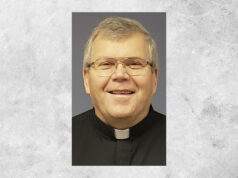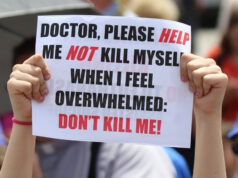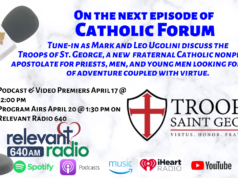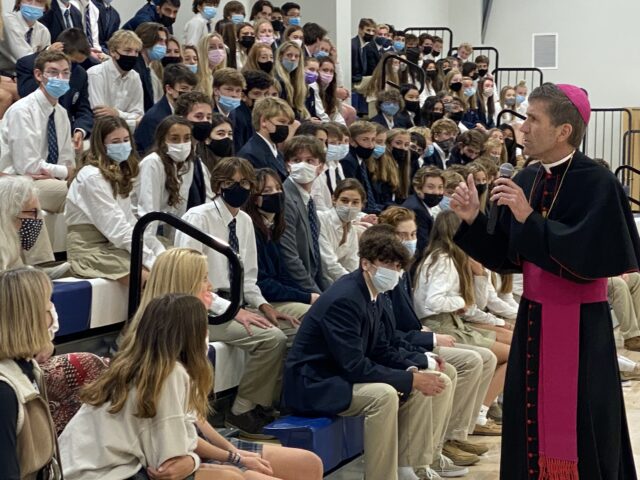
From Westover to Elkton in Maryland and from Millsboro to Hockessin in Delaware, Bishop William E. Koenig rode the wave of energy from his July 13, 2021, installation to just about every corner of the Diocese of Wilmington.
As the calendar hits mid-July, the bishop has concluded his first year as 10th bishop of the diocese. And if he didn’t meet every person, it wasn’t because he didn’t try.
“I haven’t gotten to all of them,” the bishop said of the 56 parishes (75 worship sites) in the diocese. He estimates he’s made visits to more than half. He’s tried to make the most of his weekends for local travel.
“There haven’t been enough weekends,” the bishop said in an interview with The Dialog late last month. “I’ve gotten around certainly with confirmations, but being there on a Sunday is a good opportunity to meet parishioners at that particular Mass.”
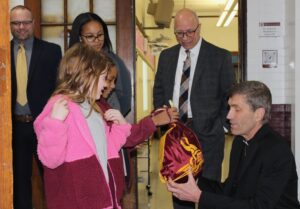
Confirmations and scheduled school trips enabled the bishop to visit all 30 Catholic schools in the diocese. He developed a game plan in each school visit, dividing the student body into three or four groups so he got face time with each of them. He enjoyed his time with the kids.
“Some of them were very impressive by the ways that they talked about the stories of Jesus and different aspects of our faith, which drives home to me the great gift of Catholic education and how our young people really form their faith through that.”
From his first day at the episcopal ordination and installation, the former priest of the Diocese of Rockville Centre (N.Y.) said he was inspired by the reception he received by the overflow crowd that turned out at St. Elizabeth Church in Wilmington. He said the welcome made an impact on him and his guests, family and friends.
“They were overwhelmed by the welcome they received,” he said. “And as I’ve made it around to the individual parishes, that’s been reinforced. And that goes for the parishioners and very much so for the priests.”
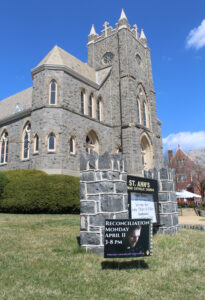
Dialog photo/Joseph P. Owens
His first year has included many significant milestones in the church, including the synod on synodality, the “Eucharistic Revival” and procession through Wilmington and the first “Reconciliation Monday” he instituted during Holy Week in the diocese when thousands of parishioners took advantage of the opportunity to make confession during the same five-hour period at every parish in the diocese.
“One of the great delights was Holy Week here in Wilmington,” the bishop said. “Beginning with Palm Sunday, but then Reconciliation Monday in which people responded. And the Chrism Mass was really a great gift. And then the opportunity to be in the Cathedral for the Triduum and be the celebrant, the presider of those liturgies, was certainly a great event. I appreciated the opportunity to do that.”
“I’ve been able to meet with various groups of people. The nice thing about the synod is to meet with various representatives of parishes in informal sessions.”
As the bishop methodically tours the diocese, he said feedback from priests and parishioners has given him a feel for the challenges, and he has begun to think about a strategic approach to positioning the diocese for the future.

Dialog photo/Joseph P. Owens
He knows it’s just the beginning, and said he expects the diocese to have an announcement soon outlining a plan to find a path to the future.
“We’ve been looking into having someone facilitate to help us as priests and as a diocese both to really kind of reflect on our needs, how we can best meet the needs, and bring the Gospel to others,” the bishop said. “And that would really entail people in parishes, the clergy and the leadership of our diocese. And it could be a process that would go over a couple of years. A big thing is having someone – an organization – that would help facilitate the process.”
The bishop and other diocesan leaders have been focused on that process, he said, and are close to rolling out an idea of how they want to pursue changes that will inevitably come.
“One of the things I heard in meeting with the priests is we have a large concentration of our parishes in the northern part of the diocese, in Wilmington, but a lot of the population has moved, and is centered in the south,” Bishop Koenig said. “So, we must look at how we can best deploy our personnel and how can we best meet the needs of the people who are throughout the diocese, both north and south. What happens in the south is some of those priests have 10 Masses. That’s a lot for two guys. What happens here (in the north) is, we have a lot of churches, so we need people in those churches, but we don’t have a lot of people coming to those individual Masses.”

Dialog photo/Joseph P. Owens
The Wilmington diocese includes a large urban center, vast suburban developments, a significant rural presence and beach and bay resorts.
“One of the things that is really neat about the diocese is the diversity,” the bishop said. “Here, you have the city of Wilmington, and you go south, and you have the farms, and the beach. It’s a beautiful place to just drive as you go down in that area.”
It also makes for a geographical challenge.
“At this point, I’m looking forward to next year as we go a little more in-depth as we look at the needs of our diocese,” he said. “To strategize as to how it might be most effective to do that. I’m looking forward to now go to the next step.”
For many Catholics, that type of discussion plus the obvious need for vocations gets them thinking about one thing: Closing/merging parishes.
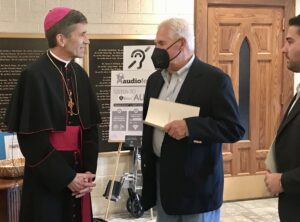
“I think that’s part of the study that we’re looking to do,” Bishop Koenig said.
“How can we best meet the needs of our diocese? Regarding personnel, regarding evangelizing, and that would entail all parishes – of how we might best do that.”
Such discussion always comes with emotional thoughts of what will remain. The bishop is aware that discussion of change brings a new beginning, but also tugs at people who would like to see things remain the same.
“It would be a process in which we would let the priests know, gather them, and present them with a picture of what we want to do, but then go to the parishes and have parishioners tell us what the needs of your parish are and explore it down. Find out what their needs are and come up with a plan in conjunction with their input.”
Amid all the work awaiting a new bishop, he has also had the chance to get a feel for the place. He lives at the bishop’s residence, a home purchased by the diocese before his arrival a short distance from the chancery, and he has had the opportunity to enjoy the lighter side of life in visits through parts of two states. He’s picked at crabs on the Eastern Shore of Maryland and tasted a cheesesteak in New Castle County. He’s visited beach towns and, an avid baseball fan, attended a Phillies game last season. He’s been a Mets fan since boyhood.

He was rained out of a scheduled appearance to toss the first pitch at a Blue Rocks game in Wilmington.
Getting a call from a papal representative informing you that Pope Francis wants you to be bishop of a place you don’t know is an unusual part of the job. On the other hand, just about every priest has had reassignments in their priesthood.
Is it the same?
“The main way it’s different is that you’re coming into a place where you have no idea of where things are,” Bishop Koenig said. “As a priest you get assigned to a parish, your focus is specifically on that parish. Now, I have to learn the names of the towns and the parishes in those towns and the priests. There’s been two levels – meeting parishioners – also, committees and organizations that are part of our diocese. That’s a little more in-depth as you work on different projects.”
He’s had a taste of Fusco’s Italian Ice in Wilmington (thumbs up!), but he remains in search of every New Yorker’s favorite morning delicacy, a crusty, chewy New York bagel. He also didn’t know where to get a haircut and was taken aback to learn many barbers require an appointment. “I’m used to just walking in,” he chuckled. He has since found a place.

Bishop Koenig made it a point to celebrate four Masses over Christmas, two Christmas Eve and two Christmas morning at four different parishes. He encountered appreciative parishioners. “That was fun,” he said.
Are there aspects of home that he misses?
“I miss in a very good way, the traffic,” said the Long Island native.
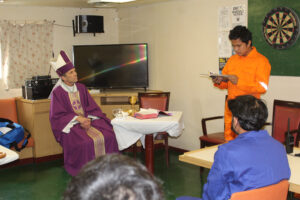
“The great thing about technology, I can stay I touch with family and friends. But it’s also two-and-a-half hours away, so I can get up there. I had my classmates here and we went down to Ocean City, and we had Mass to celebrate our anniversary. Got to see the boardwalk. My classmates from Brooklyn said, ‘This reminds you of Coney Island from 50 years ago.’”
He said people and processes are in place to keep up with growth in the region.
“I’m very grateful for the call to come to this diocese and to serve as the bishop here. I’ve been very grateful to Bishop Malooly for his great support and for all the ways that he’s really brought us to where we are today. I’m grateful for the pastoral staff that we have in our diocese and for the priests and for the laity that is so great.”
Bishop Koenig said he has spent a lot of time listening in his first year on the job.
“What I hear is a great enthusiasm for our faith,” he said.
“But I also know there are other people we want to reach out to, and that’s part of this three-year National Eucharistic Revival, to not only celebrate with the people who do come, but also to attract the people who don’t come as often.”






